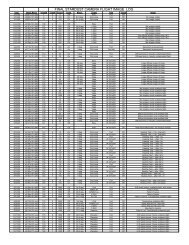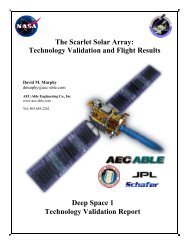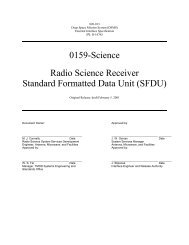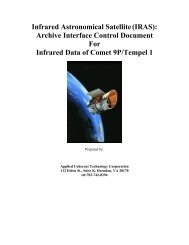MISSION PLAN - PDS Small Bodies Node
MISSION PLAN - PDS Small Bodies Node
MISSION PLAN - PDS Small Bodies Node
Create successful ePaper yourself
Turn your PDF publications into a flip-book with our unique Google optimized e-Paper software.
4.0 Cruise Phases<br />
4.1 Overview<br />
The STARDUST mission has nearly six years of relatively low activity cruise. The<br />
cruise phases are subdivided into Cruise 1 (Earth-Earth), Cruise 2 (Earth-Wild-2), and<br />
Cruise 3 (Wild-2-Earth). Within these phase are embedded the following subphases: ISP<br />
collection, Deep Space Maneuvers (DSM), and Trajectory Correction Maneuvers (TCM).<br />
Other activities that occur during the cruise phases but do not have specific subphases<br />
associated with them are the CIDA and DFMI experiments.<br />
The spacecraft trajectory for this phase is the same as shown in Figure 2.3-1. Cruise<br />
phases and subphases are defined in Table 4.1-1. The Cruise phase data set is considered<br />
the same as the Mission data set and can be found in Section 9.1.<br />
Table 4.1-1 Cruise Phase Subphase Definition<br />
Cruise Phase Sub-Phases Time<br />
(L+days)<br />
Cruise 1 (Earth-Earth)<br />
30 - 649<br />
DSM-1 (TCM 2)<br />
398 - 402<br />
ISP Collection<br />
403 - 469<br />
TCM 3 (DSM-1 + 30 d)<br />
432<br />
Cruise 2 (Earth-Wild-2)<br />
Cruise 3 (Wild-2-Earth)<br />
ISP Collection<br />
DSM-2 (TCM 7)<br />
DSM-3 (TCM 8)<br />
TCM 9 (DSM-3 + 7 d)<br />
TCM 16 (3rd aphelion)<br />
739 - 1691<br />
1267 - 1402<br />
1130<br />
1609 - 1611<br />
1618<br />
1841 - 2445<br />
2063<br />
Duration<br />
(days)<br />
619<br />
5<br />
66<br />
-<br />
952<br />
135<br />
1<br />
3<br />
-<br />
604<br />
-<br />
4.2 Interstellar Dust Science<br />
Interstellar dust collection is concentrated in the part of the trajectory where the<br />
Interstellar dust impact velocity is relatively low (inbound trajectory legs). Collection is<br />
performed only during the first two loops resulting in 201 days of total collection time.<br />
Collection is not performed on the third loop to avoid contamination of the cometary<br />
samples collected during the encounter with Wild-2. CIDA and DFMI operations are<br />
nearly continuous, essentially whenever there is sufficient power to turn the instruments<br />
on. However, prime CIDA periods can be defined as those during which the interstellar<br />
dust stream is made to fall within the field-of-view of the CIDA instrument, while not<br />
violating power availability or conflicting with other important mission activities.<br />
With passive experiments and without the need for stringent attitude control (the<br />
uncertainty in the radiant direction of the interstellar dust could be as large as 30°), these<br />
51






